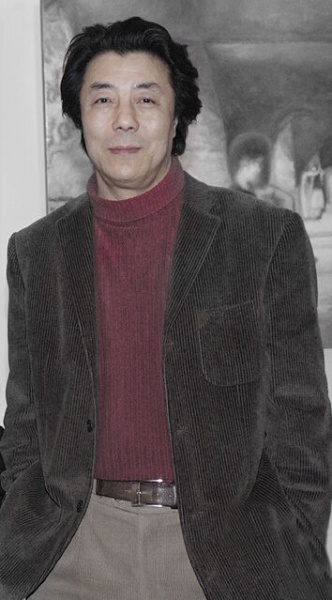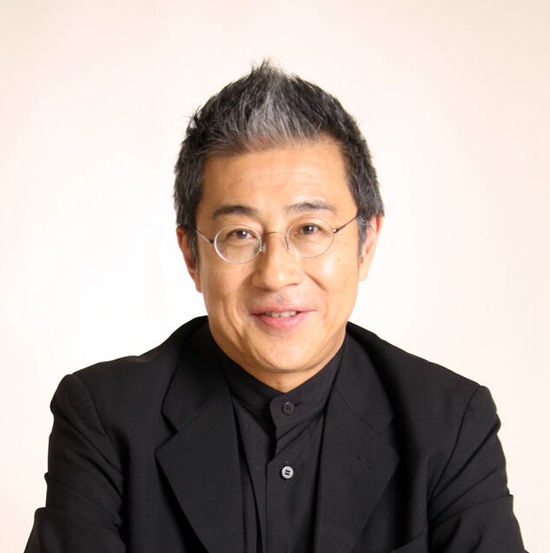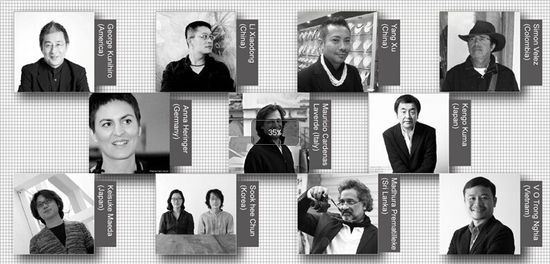2014国际竹建筑双年展 关于乡土精神的对话
关于项目
首届【国际竹建筑双年展·中国龙泉】,在龙泉巿政府的全力支持下,经过一年多的酝酿、策划、规划,以及建筑师的现场勘察,于2013年8月正式奠基。营建地:浙江省龙泉市宝溪乡。
宝溪乡位于龙泉市西陲,竹木茂盛、山高涧深,是瓯江、钱塘江、闽江的源头。其青瓷文化历史悠久,七座古龙窑留存至今,安卧于山峦溪水之间。
参加本届双年展的建筑师来自美国、中国、哥伦比亚、德国、意大利、日本、韩国、斯里兰卡、越南等(按国家首字母排名),其中包括国广乔治(George Kunihiro,美国),李晓东(中国),杨旭(中国),Simon Velez(哥伦比亚),Anna Heringer(德国),马儒骁(Mauricio Cardenas Laverde,意大利),隈研吾(Kengo Kuma,日本),前田圭介(Keisuke Maeda,日本),Sook hee Chun(韩国),Madhura Prematilleke(斯里兰卡),VO Trong Nghia(越南)。竹建筑作品包括:当代青瓷艺术馆(艺术馆装修效果图)、竹产品设计及研发中心、陶艺家工作坊、公共陶艺工作坊、水碓(瓷土制作体验馆)、青年旅社、艺术酒店(酒店装修效果图)、设计酒店、低能耗示范竹屋、接待中心等,共18座单体建筑。
"场所精神——乡土建设"是本届双年展的主题。
十一位参展建筑师,在宝溪乡实地探访,了解当地留存的乡土文脉、村落形制、民风习俗、青瓷文化、自然景象;他们溯本求源,走访竹工厂,了解传统夯土、垒石,及陶瓷技艺。在充分吸取当地文化基因的基础上,每一位建筑师都根据地势地貌,以开放自由的设计理念,弹性地表达了各自对在地性"双年展"的独特见解,完全尊重"场所精神",放弃自己惯有的建筑风格;发挥创造力、想象力因地制宜,因地取材,以当地的竹材、石材(石材装修效果图)、泥土、瓷片为媒介,釆用乡民所熟悉的"低技术"进行可持续乡村建设。双年展向世界传递了这样一种理念,"竹"经过科学地处理,完全可以建立一套行之有效的营造法则;只要根据其特性进行合理的设计,“以竹代木”将成为现实。
双年展将告诉世人,"竹"不仅仅具有精神属性,同样可以成为建筑美学、建筑诗学。在中国经济崛起的时代,伴随而至的是文化上的创新和发展,竹建筑在具备实用功效的同时,还包含了重塑乡村的抱负。
"竹建筑"在营建过程中,将遵循“取之于民,用之于民”的原则;当地的工匠参与到故乡建设中,通过建筑实践,开启明智。乡民从中学习掌握当下升级版的"低技术",开始重新认识身边的美好事物,加深对家乡的认同感、自豪感,产生文化上的觉醒与自觉。未来的宝溪乡将向世界敞开文明之窗,展现"软实力",开创中国乡村建设新路径、新格局,成为了全球第一个以"竹建筑"为美誉的魅力乡村,复兴一个古老的、沉睡的文明。
今年,国际竹建筑双年展联手十一位国际知名建筑师,相继多次深入乡村、走进乡民。在充分尊重原住民习俗、历史、生态的基础上,以国际化的视野,梳理宝溪乡的集体记忆;以青瓷文化、生态文明、公共空间为蓝图,进行乡村的社会实践;并以"竹"为载体,将文化融入建筑设计。在已完成的定向设计中,建筑师探讨了"竹建筑"与原住民及周围环境的融合性。他们用自己的智慧,创造了一个多样化的乡土中国,现代(现代装修效果图)而传统;乡村的生态空间更为广阔,现代的生活基础也更为厚实。通过"双年展"的持续发酵,媒体已逐渐聚焦宝溪乡,开始产生眼球效应,接踵而至的将是人才与思想、资源与资金的多向流动和汇聚。如何把握这个历史机遇,对政府、乡村基层干部、乡民而言,尤为重要。我们是否有了充分的准备?
在策划竹建筑双年展起始,组委会便希望通过在地性的"双年展"、国际知名建筑师、当代竹建筑社区等核心内容,塑造一个真正具有文化价值的乡村,从而完成振兴乡村的计划。
这个计划,将在项目进行中逐一展开,如:乡村教育、职业堷训、文创辅导、科技交流,以吸引建筑、艺术、设计、传媒等院校,及公共机构到宝溪进行教学实践,培养有创造力的工匠,来吸引世界各地的优秀陶艺家入驻,产生互动、互学,为当地青瓷文化注入新观念,激活青瓷文化的当代性。与此同时,吸纳具有现代农业、现代生物科技专长的自愿者来服务乡村。
中国的乡村建设需要梦想,但更需要践行者。
在宝溪乡举办的国际竹建筑双年展,它是全球第一个在地竹建筑双年展,它对中国未来的乡村可持续发展、文化复兴与重建、乡村转形与升级,提供了有益的尝试。作为一个在地性的"双年展",它根植于乡村的土壤,创新了乡村建设;作为一种个案的文化选择,开始受到广泛关注。它并非乌托邦式,也非静态。它以日常生活的方式,融入到乡村,发生在我们身边,生生不息;它以一种乡村聚落的形式,展示了人与自然、人与建筑、人与环境的互动关系,创新了乡村的社群文化与社交生活。耕作之余,乡民们开始有了广泛的文化选择:竹建筑社区、当代青瓷艺术馆、公共陶艺工作坊、竹产品设计及研发中心,都将成为乡民的社交"广场"。乡民开始拥有自己的公共空间、文化资源,随着国际交流日益増多,乡村文明因多样性而鲜活,因创造力而充满魅力。
竹建筑双年展源自生活,“再造魅力故乡”便是它的“根”。通过六年三届的囯际竹建筑双年展,"国际化"将会成为宝溪乡在"中国版图"上的代名词。低碳环保型竹建筑社区、丰富多样的乡村生活、自然清新的田园(田园装修效果图)风光、国际陶艺村、引以为豪的青瓷历史、乡村的发展路径,一切软实力将显得更为清晰。
参加本屇双年展的意大利建筑师——马儒骁,这样说道:“在我看来,双年展就仿佛一方沃土,当无数种子开始孕育时,它们必定在邻里间、乡村间相互作用。一些种子需要照料,一些种子自己就能茁壮成长,但最终它们都会在这片土地上绽放。我坚信,这一切会在这里开花结果,对于我们建筑师和那些深爱着这片土地的人来说,意义非凡。这只是过程,而不是暂时的成功。”
今天,在宝溪乡的地平线上一片曙光,愿景已经展开——
时间将证明一切!
策展人简介

葛千涛
葛千涛,策展人、艺术家。
2010年—2011年 中国意境— “人类非遗龙泉青瓷”—巴黎—上海
2007年 惊蛰—当代艺术展,第七届UBS瑞银大中华年会
2006年 法国著名雕塑家阿曼艺术展—上海泰晤士小镇美术馆
2004年 上海城市雕塑展—上海梅龙镇广场
总监
2011年 “中国动漫节•影视周”—日本东京
2009年—2011年 上海国际陶瓷生活艺术博览会
2003年—2011年 上海春季艺术沙龙
2003年 上海自来水展示馆

国广乔治 George Kunihiro
国广乔治,美国建筑师协会会员,著名建筑师、教育家。现任职东京国士馆大学的建筑系教授。
2013年 美国建筑师协会委员会国际主任。
2011年至2012年 亚洲建筑师协会主席
2011年 北京清华大学客座教授
2009年 美国建筑师协会院士团团员。
George Kunihiro
George Kunihiro, FAIA, is a noted architect, educator. Now he is a Professor of Architecture at the Kokushikan University in Tokyo.
2013 The International Director on the National Board of the AIA.
2011—2012 The President of the Architects Regional Council Asia.
2011 Visiting Professor at Tsinghua University.
2009 The College of Fellows of the AIA.
参展建筑师简介(排名不分先后)

国际竹建筑双年展 参展建筑师头像排列
1、国广乔治,美国建筑师协会会员,著名建筑师、教育家。从哈佛大学设计学院取得建筑学硕士后,他又在加州大学伯克利分校获得艺术(艺术装修效果图)学士学位。现在,他任职东京国士馆大学的建筑系教授。1980年,国广教授在旧金山开设了私人事务所。随后,他在洛杉矶及纽约设立了办公室,并在美国和日本完成了大量建筑项目。1997年,国广教授将自己的大本营迁至亚洲。十五年时间,他专注于自己的事务所,并潜心研究当代社会的现代(现代装修效果图)亚洲文物建筑。
George Kunihiro, FAIA, is a noted architect / educator. He is a Professor of Architecture at the Kokushikan University in Tokyo, Japan. Professor Kunihiro received Master of Architecture from Harvard University Graduate School of Design and Bachelor of Arts from the University of California / Berkeley. As an architect, In 1980, Professor Kunihiro began his private practice in San Francisco. Subsequently, he opened his office in Los Angeles and New York and designed numerous projects in the United States and in Japan. In 1997, Professor Kunihiro moved his base to Asia. For fifteen years, he has focused his practice and research on the modern Asian heritage in the contemporary society.
2、李晓东,1984年毕业于清华大学建筑系,后在荷兰德尔富特大学及安德毫芬大学获得城市设计硕士学位及建筑学博士学位,现任清华大学建筑学院教授。
李晓东相信优秀的设计必定经历了技术与艺术的共同作用,更是精神探索与理性思考的结晶。一件内涵丰富的设计作品依赖于建筑师对细节的雕琢,尺度的把握,比例的推敲,以及对基本标准的坚持。
Li Xiaodong graduated from Tsinghua University in 1984, then completed his Master of Urban Design and Doctor of Architecture at Delft University of Technology and Eindhoven University of Technology in Netherlands. Now he is a Professor of Architecture at the Tsinghua University in Beijing. Li believes that a good design product is the result of spiritual exploration of ideas with rational thinking, it engages with both technical knowledge and artistic judgment,the richness of a good design rely on how the matrix of detail, scale, proportion and commonsense are carefully orchestrated.
3、杨旭,1967年生于上海。1991年毕业于上海大学美术学院环境艺术系。2002年,他以自己的姓名为名组建了建筑工作室——杨旭建筑工作室。作为本届【国际竹建筑双年展】的总体规划师,他还参与了其中两栋建筑的设计。
Yang Xu was born in Shanghai in 1967. He graduated from Environment Art of Shanghai University in 1991. Eleven years later, he has established Yang Xu architecture studio. As a planner for master plan of this International Bamboo Architecture Biennale, he also has participated in biennale with two buildings.
4、西蒙·维列,1949年2月2日出生于哥伦比亚马尼萨莱斯的一个建筑世家。1968年,西蒙进入波哥大安第斯大学学习建筑及艺术。毕业后,他利用天然材料在奥里诺科河国家公园等地设计了一系列住宅楼宇。西蒙•维列是低技术生态建筑的代表人物之一——善于使用低成本建筑材料——尤其是天然材料的运用。所以,其设计主要服务于贫苦大众,为那些挣扎于贫困线下的穷人建造住宅。此外,他潜心研究建筑屋顶的设计,并自称“屋顶建筑师”。
The son and grandson of architects, Simon Velez was born in Manizales, Colombia, in 1949. Simon received a bachelor from Universidad de Los Andes in 1968. After graduation, he designed several houses at Orinoco national park with natural materials. Simon who is famous for the use of natural materials in the world, is a representative of Low-Tech Ecological architecture. He designs with a commitment to convert bamboo from a symbol of poverty into a symbol of sustainability.
5、对于安娜而言,建筑是一种提高生活品质的工具。19岁时,她花了整整一年时间在孟加拉国深入学习,从那时起,她便将自己的热情附在开拓性工作上。安娜的可持续性建筑享有国际声誉——孟加拉国卢德拉普尔的METI手工制作学校便是她与Eike Roswag在2006年按其当初的毕业设计所建。之后,海瑞格结合当地工人技术及建筑材料,在同一个乡村里完成了另一些建筑项目,以进一步发展自己的建筑方法。作为大学客座教授,该方法同样被应用于林茨艺术大学、斯图加特大学及维也纳技术大学的课程教学。
For Anna Heringer architecture is a tool to improve lives. At the age of 19 Anna spent a year in Bangladesh as development learner. Since then development-work is her passion. She established her international reputation in sustainable architecture with the construction of the METI School of Rudrapur, Bangladesh, a project she designed for her graduation thesis and carried out in 2006 together with Eike Roswag. Since then, Heringer has further developed her award-winning architectural approach based on the use of local building materials and labor in several building project in the same Bangladeshi village, as well as in her architectural teaching at the University of Arts Linz, the Stuttgart University and the Technical University in Vienna, where she obtained visiting professorships.
6、马儒骁•卡德纳斯•拉韦德,于1969年8月3出生在哥伦比亚首都——波哥大。1993年,他在哥伦比亚安第斯大学建筑学院取得学士学位。第二年,便在纽约雪域大学建筑设计专业获得硕士学位。随后,马儒骁受雇于东京的明治·渡边联合公司以及巴黎的伦佐·皮亚诺工作室;前者是一家专业建筑设计公司,而后者则是意大利当代著名建筑大师所创立的著名设计公司。经过多年实践,他累积了丰富的设计经验,并在2002年以其论文《工作空间的敏感性环境设计》获得米兰理工大学室内建筑学院的博士学位。2004年,卡德纳斯在米兰创立了以其姓氏命名的设计公司——卡德纳斯意识设计公司。从2006年至2010年,他还担任了英国奥雅纳工程顾问公司的立面工程顾问——参加在米兰、伦敦等城市的各类国际性项目合作。
Mauricio Cárdenas Laverde,born in Bogotá, Colombia in 1969. Cárdenas received a Bachelor of Architecture from Universidad de Los Andes Bogotá, Colombia in 1993. In 1994 he received a Master of Architecture from Syracuse University in New York and began collaborating with leading architecture firms such as Studio Meiji Watanabe & Associates in Tokyo and Renzo Piano Building Workshop in Paris. In 2002 he received a Ph.D. degree from the Politecnico di Milano School of Interior Architecture with a dissertation on “Design of Environmentally Sensitive Work Spaces”. In 2004 he founded Studio Cárdenas Conscious Design in Milan. From 2006 to 2010 parallelly to the studio activities, Cárdenas was consultant for Arup Façade Engineering where he divided his time between Milan and London, working on a wide range of international projects.
7、隈研吾,1954年出生于日本,1979年在东京大学获得硕士学位。1985年至1986年间,他以访问学者的身份就读于美国哥伦比亚大学。1990年,他在东京青山创立了隈研吾建筑都市设计事务所(Kengo Kuma & Associates)。之后的2001至2008年,隈研吾就职于庆应义塾大学;并于2008年在美国伊利诺大学香槟分校任职。第二年,他在东京大学的建筑研究生院担任教授一职。
Kengo Kuma was born in 1954. He completed his master’s degree at the University of Tokyo in 1979. From 1985 to 1986, he studied at Columbia University as Visiting Scholar. He established Kengo Kuma & Associates 1990. He taught at Keio University from 2001 to 2008, University of Illinois at Urbana-Champaign in 2008, and in 2009, he was installed as Professor at the Graduate School of Architecture, University of Tokyo.
8、前田圭介,1974年出生于日本广岛,1998年毕业于国士馆大学。在2003年,他创立了自己的UID建筑工作室。前田是极富潜力的日本年轻建筑师,他坚信建筑应该激励并吸引欣赏者,尤其希望自己的作品能给人以愉悦感并让人留下深刻印象。所有作品的成功都基于一系列的合作关系。第一种合作便是客户与建筑师间的思想合作,设计不仅与客户的需求有关,更与他们的个性息息相关。第二种合作便是建筑设计及其地理位置的合作,建筑必须与周围景观相融合。第三种合作即是UID工作室的团队合作,这是保持高品质设计的关键所在。
Keisuke Maeda was born in 1954 and graduated from Kokushikan University in 1998. He established UID Architects in 2003. Keisuke Maeda is young up and coming Japanese architect based in Hiroshima. He believes strongly that architecture should stimulate, engage and challenge the viewer. Above all he hopes that those who see his work will enjoy the experience and be left with a lasting impression. The success of each project is based on a set of partnerships. The first of these is the partnership of minds between clients and architect. For a design to become a home it is necessary to incorporate within it not just the wishes of the client but also wherever possible aspects of their personality. The second partnership is that between the design and its future location. The final structure must sit together in dialogue with its surroundings. The third and equally important partnership is the one that exists between Keisuke and his associates at UID. Theamwork is the key to ensuring the final product is of the highest standards.
9、Sook Hee Chun,美国建筑师协会及认证专家,生于1975年。在韩国梨花女子大学完成建筑本科学位后,从普林斯顿大学获得建筑硕士学位。她是注册建筑师,曾在纽约格瓦思梅·西格尔建筑师事务所与首尔履露斋建筑事务所实践工作。
Sook Hee Chun, AIA, LEED AP, born in 1975, received her Master of Architecture from Princeton University after received BS in Architecture from Ewha Womans University in Korea. She is a registered architect whose background includes such major international design firms as Gwathmey Siegel & Associates Architects in New York, and Iroje Architects and Planners, Seoul, Korea.
10、Madhura Prematilleke,斯里兰卡建筑师及城市设计师,他带领的teaM Architrave团队已经成为科伦坡主力建筑设计团队。Madhura曾在斯里兰卡的莫勒图沃及芬兰的赫尔辛基学习建筑设计,并在斯里兰卡、芬兰、印度、中国、阿曼和马尔代夫参与项目设计。同时,他还积极参与大学教学,及国际会议演讲活动。
Madhura Prematilleke, principal of teaM Architrave Colombo, is a Sri Lankan Architect and Urban Designer. Madhura studied architecture at Moratuwa (Sri Lanka) and Helsinki, and has worked in Sri Lanka, Finland, India, China, Oman and the Maldives. He has lectured and taught extensively at international conferences and universities.
11、武重义,1976年出生于在越南广平省。2002年,在获得日本政府奖学金后,于名古屋工业大学学习建筑设计。两年后,他取得东京大学的土木工程设计硕士学学位。毕业后,他重返越南,2006年开始设立自己的建筑事务所。武重义利用竹子等环保材料,创作可持续建筑设计。
Vo Trong Nghia was born in Quang Binh province, Vietnam, in 1976. He studied architecture at Nagoya Institute of Technology as a student on the Japanese government’s scholarship in 2002. Then he completed his master’s degree at the University of Tokyo in 2004. After graduation from the University of Tokyo, he returned to Vietnam and started his own architectural office in Vietnam, Vo Trong Nghia Architects since 2006. He creates sustainable architectural through using environmentally – friendly materials such as bamboo.
参展项目简介
传统青瓷作坊 国广乔治
Existing Ceramic Workshop•George Kunihiro
该建筑是当地原有的陶瓷工作坊。建筑的环境控制系统依赖于自然通风、夯土墙的耐温性,以及湿度传递性。南北方向的窗户可以对流通风,因此无需安装任何采暖设备。所有的照明器材,将采用荧光灯及LED设备,可以为工厂提供合适的灯光效果及氛围。
Environmental control system of the building relies on the natural ventilation and the performance of rammed earth walls for the thermal and humidity transfer performance. Cross ventilation will be generated from the placement of windows on the north and south facades. No mechanical heating, ventilation and air conditioning will be installed. All lighting fixtures will be fluorescent and LED fixtures. The fixtures will provide for efficiency on lighting quantity to create appropriate quality of illumination for factory and atmosphere for interior spaces.
竹产品设计及研发中心 李晓东
Bamboo Product Research and Design Center Li Xiaodong
该项目被四周的竹林所包围,因此“竹”便成为了建筑立面的主要材料。研发中心的一层、地下室及其通道,被设为产品陈列、工艺展示,以及功能区。第二层,配有多功能阶梯厅与观景台;在这里,阶梯即是书架,也是座位。
The project is surrounded by bamboo forest. Therefore, bamboo is the main material. The first floor of the R&D center, the basement and the gallery are set for product display, technology exhibition and functional zone. In the second floor there are multi-function ladder hall and viewing deck. Here the ladder present both bookrack and seat.
艺术酒店 杨旭
Art Hotel Yang Xu
该酒店(酒店装修效果图)沿着平坦的农地,盘旋而起。每个房间都被螺旋平板抬升至不同层面,衔接而上,与当地现存的古龙窑遥相呼应。因此,在设计该酒店时就需要考虑,如何让人们通过倾斜的坡面联想起龙窑。酒店由两部分组成,其核心承重墙的砖块来自当地砖窑,不规则外围由直径为10厘米的当地竹子构成。
The hotel is intended as a spiral lies on the flat farmland, the spiral slab which gradually upraises rooms onto different levels with an uninterrupted incline, reminiscently responds the existing preserved dragon kilns in the site. On that account, the hotel is taken into consideration from dragon kiln through sloping slab, instead of standard rooms. Structurally, the hotel is consisted of two components, the core bearing wall made of bricks fired in local kiln, and the posts ranged along the contour of the irregular circumference, made of 100mm diameter local bamboos.
精品酒店 Simon Velez
Boutique Hotel Simon Velez
该酒店依山而建,因此其支撑柱的长度随地势变化,长短不一,建筑底端的水泥墩则保持了统一高度。一根根完整的竹子勾勒出屋顶轮廓,其竹根顺势而下,形成屋檐;屋顶的立面,则由当地青瓷平铺而成。
The length of each support columns are different as this project is built on the hill, but the pillars which support the columns are in the same level. The roof is made by bamboo and its facade design will be made by celadon.
青年旅社及设计酒店 Anna Heringer
Youth Hostel & Design Hotel Anna Heringer
龙泉因其独特的青瓷文化,在中国陶瓷领域占有不可替代的位置。该建筑形体的灵感就来源于那些传统青瓷,极具区域代表性。我们希望,通过该项目来发展竹的结构及编织技术,使其达到与青瓷一样的成熟水平;同时,通过这种传统工艺的传承,提高人们的文化意识——“竹”具有和陶瓷一样的当代性。
Renowned for its exemplary tradition of ceramics, Longquan occupies a special place in Chinese traditional craftsmanship. The proposed structures draw inspiration from these timeless ceramic forms that also represent the identity of this place and transfer them to a different material: bamboo. The project aims to facilitate a process that brings bamboo construction and weaving techniques to a status of excellence equal to the extraordinary skills in the field of ceramics.
By raising awareness of bamboo as a modern, excellent structural, ecological building material and as an applied art on par with that of ceramics, Longquan and Baoxi ensure that it’s tradition of regional handicrafts will endure.
水碓(瓷土制作体验馆) Mauricio Cardenas Laverde
Water Power of Trip-Hammer (Life Museum) Mauricio Cardenas Laverde
我们要打造一个体验馆,让游客了解龙泉青瓷产地所制陶土的过程。体验馆如同一个保护盒,在保护整座陶土制作坊(包括水池,水碓,水磨等)的同时,让其不受干扰地持续日常陶土制作。因此,这里设有两条独立通道:一条地面员工通道,一条街面游客通道。游客可以步行穿过这些空间,在俯视陶土制作的同时享受周围美景。这种设计保留了陶土制作坊里所有的现存通道,以供这个传统的陶土生产厂继续工作。
The project regards a container, a structure to protect the historic clay factory in all its parts (water tanks, trip-hammers, water mill, etc) and to allow the clay making process to continue without interferences. For this we propose two separate paths: one for the workers on the ground level and a separate path for the visitors at the street level. Visitors can walk through the spaces on a higher level looking from above the clay production and enjoying of the landscape at the same time. Main concern for us is to protect all the existing parts of the Water Power of Trip-Hammer for mixing Pottery Clay so that the traditional clay production factory keeps working as it is today.
低耗能示范竹屋 Mauricio Cardenas Laverde
Eco Energy Efficient Experimental House Mauricio Cardenas Laverde
该项目探索了关于最大限度降低碳排放的可能性,用以提高环境保护及自然生态发展水平。通过利用宝溪乡的自然资源,如阳光、水流、植物、自然风等多种天然材料来设计创新型生态竹屋。“竹”,这种非常特殊的自然资源将被应用于室内设计及房屋结构设计;“地下水”,作为一种天然资源可被合理用于冷却降温。同时,“风水”这一极具象征性的中国传统概念,也被应用于竹屋设计。
Our proposal explores the potentiality of minimize carbon emissions,to maximize environmental protection and natural ecological development through the use of the natural elements available at Baoxi area, such as sun, water, plants, wind and natural materials to achieve a high standard innovative house for the Chinese context. Bamboo, is a very special natural element present in Baoxi area which we will use as structure for the house as well as for the interiors. Ground water cooling, underground water is an interesting natural resource available on site. Use underground water in a very simple manner to create a cooling system and also use for toilets where non-drinking water is acceptable. Feng shui, to learn and apply the most significant concepts of this antique Chinese tradition to the house design.
竹桥 Mauricio Cardenas Laverde
Bamboo Bridge Mauricio Cardenas Laverde
竹桥的灵感来源于1485-1488年间李奥纳多·达·芬奇的悬拱桥设计草图。木质结构在组装时无需嵌固件,只需运用层叠元素来满足其承受力。建筑外观简洁,并可以充分利用当地的自然材料来搭建这座桥。
Our idea for the bridge is inspired in a Leonardo Da Vinci’s sketch from about 1485-1488 regarding a self-supporting bridge which wooden structure is assembled without fixings but just by overlapping elements.
当代青瓷艺术馆 Kengo Kuma
Contemporary Celadon Ceramic Museum
当代青瓷艺术馆(艺术馆装修效果图)的设计灵感来源于一种地板板材——重竹。在这个项目里,它作为一种结构元素融入建筑设计。而对当地自然材料的充分运用,则是该项目的关键。
The design inspiration of Contemporary Celadon Ceramic Museum is from local laminated bamboo blocks, which is normally sliced and used for floor board. They are used in entirely different way –as structural elements of the architecture in this project.
陶艺家工作坊 Keisuke Maeda
Invited Ceramist Workshop Keisuke Maeda
该建筑为陶艺家提供了一种亲近自然的机会,设有起居室,及多功能工作室。用当地材料制成的钢筋混凝土墙,将每个区域分隔开来。墙面由直径为5厘米的竹管构成,被不规则地平行铺开,用作保护内部隐私等功能。我们希望,入驻的陶艺家能与周围自然环境产生共鸣,从而获取源源不断地创作灵感。
This time, for the design of the studio and dwelling of a ceramist, we propose the new architecture which adapts itself to the scenery of Baoxi in that people are living with rich and beautiful natural environment.
As overall planning, we designed that some clods which include a sitting-room and a studio function overlap in a 45m bamboo like the fan state, and they make space like the landscape of the bamboo grove of large connection. Moreover, the bamboo pipe covers the whole with arranging the about φ50 bamboo in parallel irregularly and that serves as a membrane which secures internal and external relation, privacy, etc. We think that just the environment which resonates with natural evokes a ceramist's creativity, and that it becomes sustainable structure in this background.
竹坞•餐厅 Sook Hee Chun
Bamboo •Restaurant Sook Hee Chun
竹子弯曲时,更具承重力。因此,我们用这种造型作为内墙及屋顶结构,无需额外的支撑,通透却不失隐秘性。这样,不仅节约了建造成本,还为环保节能型建筑提供了示范作用。餐厅(餐厅装修效果图)的九宫格结构与几何造型体现了独特的建筑魅力,其主结构节点以钢筋作为主轴,利用弯曲的竹子构成不同的曲面,如同竹海中错落的山脉。
公共陶艺工作坊 Madhura Prematilleke
Public Ceramic Workshop Madhura Prematilleke
该建筑位于两处水平面之间,其公共走廊被置于高位,且可俯瞰整个公共区域;观景台被置于低位,与溪水相应。经东面的小型空地即可进入该建筑,穿过通道便能到达主空地。体验者能在这种简单和谐的环境里,获得创作灵感。
The building is at two levels. On the upper level it rests on the retaining wall. The major spaces are at the lower level Public verandahs on the upper level respond to the public square. Waterfront courts on the lower level respond to the stream: we propos that this waterfront court is extended to the west. The building can also be entered from the minor square on the east, via steps. This also creates a path through the building linking the major and minor squares.
接待中心 VO Trong Nghia
Welcome Center VO Trong Nghia
该建筑既是接待中心,也是办公区域。其弧形墙体及屋顶,由弯曲的竹子建构而成。利用竹子的强度与韧性打造出通透的空间,以体现竹子的独特魅力。曲线造型,使其如同河边倒映的弯月,宁静而安逸。
Here this project presents both welcome center and administrative area. The bamboos make up the walls and roof, which shows the uniqueness of bamboo perfectly.
相关知识
2014国际竹建筑双年展 关于乡土精神的对话
北京国际设计周携平行展亮相威尼斯建筑双年展
第十四届威尼斯国际建筑双年展预告会
大幕开启∣“2014中国室内设计周 第十届中国国际室内设计双年展开幕式” 在北京
第15届威尼斯国际建筑双年展中国城市馆
建筑本质已经崩塌?威尼斯建筑双年展拒绝当代建筑
一场完全没有当代建筑的威尼斯建筑双年展
第十届中国国际室内设计双年展 评审会在北京召开
第十届中国国际室内设计双年展开幕式
第十二届威尼斯建筑双年展中国呼应展在北京举行









